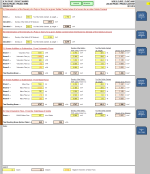Slurry Bulk Density

Description
Calculation to determine the flows and densities of combined mineral slurries. The password is '' to prevent possible corruption.
A) Determination of the Density of a Pulp or Slurry for a given Solids Content when it is known for an other Solids Content
B) Determination of the Density of a Pulp or Slurry for a given Solids Content when the Bone Dry Density of the Solids is known
C) Stream Addition or Subtraction - From Volumetric Flows
D) Stream Addition or Subtraction - From Mass Flows
E) Total Volumetric Flow - From the Total Mass of Solids
Calculation Reference
Mineral Slurry Density
Mineral Slurry Flow
Concrete Slab
To determine the flows and densities of combined mineral slurries, you need to know the properties of each slurry and their proportions in the mixture. Here's a step-by-step guide on how to calculate the combined flow rate and density of a mixture of mineral slurries:
- Determine the properties of each slurry: For each mineral slurry, obtain the following information:
- Flow rate (Q1, Q2, ...): Measure of the volume of slurry flowing per unit of time (e.g., gallons per minute, cubic meters per hour)
- Density (ρ1, ρ2, ...): Mass of the slurry per unit volume (e.g., kg/m³, lb/ft³)
- Calculate the combined flow rate: To find the combined flow rate of the mineral slurries, sum up the individual flow rates:
Q_total = Q1 + Q2 + ... + Qn
- Calculate the mass flow rate of each slurry: Multiply the flow rate and density of each slurry to find its mass flow rate:
m1 = Q1 * ρ1 m2 = Q2 * ρ2 ... mn = Qn * ρn
- Calculate the total mass flow rate: Sum up the mass flow rates of all the mineral slurries:
m_total = m1 + m2 + ... + mn
- Calculate the density of the combined slurry: Divide the total mass flow rate by the total flow rate to find the density of the combined slurry:
ρ_total = m_total / Q_total
Now you have the combined flow rate (Q_total) and density (ρ_total) of the mixture of mineral slurries.
Please note that this calculation assumes that the mineral slurries mix homogeneously and that there is no significant chemical reaction or change in volume upon mixing. Additionally, this calculation is based on the mass balance and volume balance principles, and it may not account for complex rheological properties or other factors that could affect the actual behavior of the mixed slurry.
Calculation Preview
Full download access to any calculation is available to users with a paid or awarded subscription (XLC Pro).
Subscriptions are free to contributors to the site, alternatively they can be purchased.
Click here for information on subscriptions.


